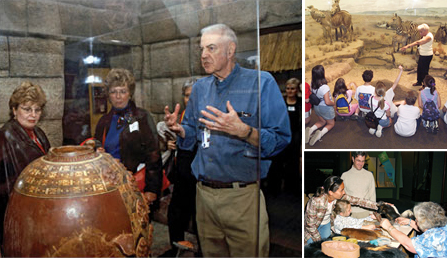 Spring 2007
Spring 2007|
|
The Natural History Docent
Opening any new exhibit—especially one on the grand scale of Dinosaurs in Their World—requires educating not only visitors, but a wide range of museum staff. From those greeting visitors at the door to a small army of museum educators and volunteers, all must be prepared when the exhibit doors swing open to the public. For the docents who will guide groups of every age and interest through the pre-historic experience—from school children and their teachers, to dinosaur enthusiasts and senior citizens—this literally means heading back to the classroom. Consider all of the wonderful nooks and crannies of the Museum of Natural History and the treasures tucked inside them. For this reason, the docent manual is four to five inches thick, and comes with worksheets and written tests (which are graded) during a two-year training program. There’s a lot to know about lions, tigers, and bears—and Egyptian mummies, too. Add to that new science about Carnegie Museums’ famous dinosaurs, environments they lived in, and the animals that lived alongside them. And it’s not just about memorizing a few intriguing facts. Whatever the museum provides on its school-group tours must fit into school curriculums, explains Cathy Andreychek, the museum educator who coordinates docent training with input from museum scientists, researchers, and fellow education colleagues. “Teachers must get their schools’ permission to bring their classes to the museum,” says Andreychek. “So it’s critical that the product we offer schools fits into state standards and is something teachers can use to enhance classroom learning.” So in September, the Museum of Natural History will begin offering special training for new and existing docents focused solely on Dinosaurs in Their World. All told, docents will receive nine hours of training a week for about two to three months. And new docents will be trained on the remaining exhibits at a later time. Training is a huge brain dump, for sure, say long-time docents, but the pay-off is immeasurable. “The breadth of material we learn is wonderful—from botany to geology to gems and minerals,” says Bill Buckley, who worked in computer education at Alcoa for 35 years before donning a docent’s badge. “I’ve been working with dinosaurs for 11 years, and with the opening of Dinosaurs in Their World, I’ll learn even more about them, and sometimes straight from the scientists. It’s fantastic. The fun is tailoring the information for each audience, and helping to bring the museum to life for visitors.” And they’re among interesting company: The museum’s docents include retired school teachers and college professors, architects, at least one engineer, former businessmen, and a bunch of generally active, life-long learners engaged in their community. “I’ve always enjoyed children, and as a retired teacher this is an extension of being in the classroom, doing what I love,” says Elise Bennett, who in 1991 was the first African-American docent. Of course, being a docent isn’t just about what you know but how you deliver the information. Part of the training includes presentation techniques, how to involve students, and a brain trust of tips on what makes a successful tour. “As docents evolve they work out their own unique ways to deliver the information,” says Andreychek. “They learn from each other and really have fun with it. We are so fortunate to have such a gifted, dedicated group of people who donate their time in this way.” For more information about the docent program, contact Cathy Andreychek at 412.622.3233 or andreychekc@carnegiemuseums.org
|
Also in this issue:
One Hot Topic · West Looks East · Golden Years · Off the Wall …and Into Packed Theaters · Director's Note · NewsWorthy · Now Showing · Face Time: Lareese Hall · Artistic License: Bizarre Beasts · First Person: Video Art, by Douglas Fogle · About Town: Let's Explore · Science & Nature: In Search of the Best Visitor Experience · Then & Now: Hillman Hall
 |
Copyright © 2017 CARNEGIE Magazine. All rights reserved. |

